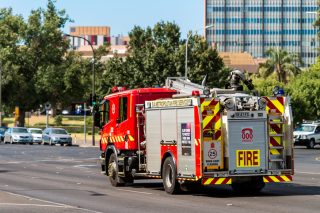The blaze at the Narangba chemical plant in August 2005 was the biggest and fiercest most of the fire officers had seen. It destroyed the factory and several warehouse buildings.
Twelve fire crews attended streaming massive quantities of water into the inferno.

The water combined with the chemicals to precipitate an environmental catastrophe not only on the site itself but also on neighbouring land.
Not only having to contend with the destruction of its building, production line & stock, the business owner Hamcor Pty Ltd was issued with Environment Protection Authority notices to remediate the contamination at a cost more than $9 million, “many times the value of the land before the fire”.
Unless the contamination is removed, the land cannot be put to any use whatsoever.
Hamcor’s owners Terry Armstrong and Don Hayward sued the Queensland Fire Service alleging that it was negligent to attempt to extinguish a chemical fire with water rather than to allow it simply burnout.
The company also sued its insurance broker on the basis that it had failed to allocate proper insurance cover and note the respective risks as between the business on the one hand and its related company that owned the site, on the other.
It was the unanimous view of the experts for both the plaintiff and the state, that there was no point in applying water to extinguish the fire.
That was because of the extremely high temperature at which chemical fires burn. In the words of one of the experts: “No amount of water would have put that fire out. No amount of water whatsoever”.
Justice Jean Dalton was required – by reason of there being no prior Australian authority on the issue of fire brigade negligence per se – to conduct an exhaustive examination of related case authorities on the liability of statutory authorities and fire service liability.
She ruled that the fire service did owe a duty to take reasonable care not to damage to property when acting to combat a fire and that the resulting damage was, in this instance, foreseeable.
But the plaintiff had further hurdles to clear.
Civil Liability Act s 36 required the plaintiff to prove that the actions of the service were – in addition to being negligent – were “so unreasonable that no other fire authority could consider them reasonable”.
She ruled that s 36 applies only to claims of breach of statutory duty – not common law breach claims the subject of the proceedings – but went on to consider what would have ben the consequences for the plaintiff had the section been applicable.
If s 36 did in fact apply, in Her Honour’s view, the “unreasonableness” that the plaintiff had to prove was at a far higher level than mere negligence. “In my view these words require the kind of unreasonableness which invalidates, or makes improper, the act or omission as an exercise of statutory power.”
No particular evidence addressed this issue but her Honour was satisfied that the presence of several senior and many other experienced officers who did not intervene to stop the application of water, was suggestive that such strategy was not so unreasonable.
“Had the breaches complained been of the magnitude required by section 36, it is inconceivable that no officer would have averted to them and stopped them”.
Her Honour noted the s 36 provision makes it “extraordinarily difficult for a plaintiff to prove breach”.
Fatally for the property owner, she ruled s129 of the Fire and Rescue Service Act meant that the fire officers have immunity when their actions are “pursuant to the Act” as was the case at Narangba. The immunity arose under the first limb of the section because the application of water to extinguish fire was an act directly authorised by the statute. On the other hand no immunity would extend to them under the second limb which, to apply, requires such acts to be done “without negligence”.
The insurance broker was also sued. That claim was premised on the basis he had failed to put in place effective cover for the related landowner entity that would have responded to the estimated costs of remediation of the contamination.
But the evidence suggested Armstrong – who died before judgment was delivered – was less than effusive in his instructions to broker Stuart Munro – a member of Austbrokers group – who took over the factory operator’s insurance when he purchased its former broker’s business.
He asked to review the property insurance in October 2004 but Armstrong didn’t respond. He also offered to investigate public liability insurance for the factory operator but the documents he requested be furnished to him for this task were only provided “piecemeal” and some were incorrect.
The claim against Munro during the fire service liability case was dismissed on the basis that the plaintiffs had placed no reliance on him to conduct a wide-ranging review that rather had limited his instructions to effecting damage insurance for the improvements only.
“I am unable to conclude that the plaintiffs would have acted in accordance with the advice or would have acted as a diligent and responsible director had he been offered the advice. The evidence as to Mr Armstrong’s attitude to insurance tends to suggest the contrary”.
“There were risks which Mr Armstrong and Mr Hayward were prepared to take. The steps taken to make the site more attractive to a potential purchaser” show that they were comfortable with assuming quite significant risk in their commercial enterprises”.
They had also had experience with insurance claims concerning a fire at their West Australian plant from which the court found it “very difficult to believe that he did not come to appreciate that there was an inadequacy” in the insurance arrangements for the entities and the Queensland business and land.
After a 15 day trial all the plaintiffs’ claims were dismissed and they were ordered to pay costs. The plaintiffs had conducted earlier proceedings which went all the way to the Court of Appeal but which also did not go they way that they had hoped.
An appeal against Justice Dalton’s rulings was filed today.
Hamcor Pty Ltd & Anor v State of Queensland & Ors [2014] QSC 224 Dalton J 01/10/2014
P.S. Hamcor’s appeal against the above decision in favour of the State of Queensland was dismissed in October 2015 when three appeal judges endorsed the reasoning of the trial judge on all points.




0 Comments